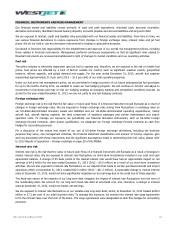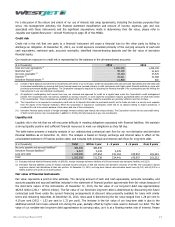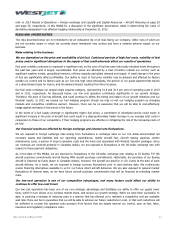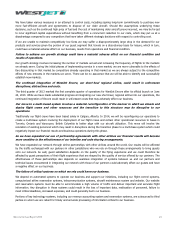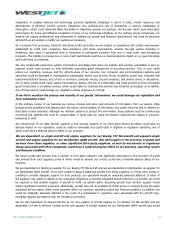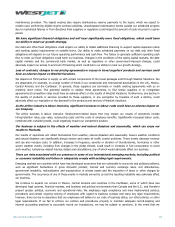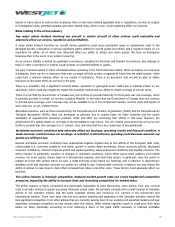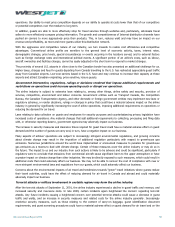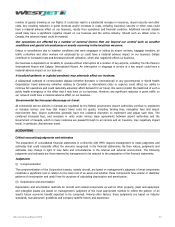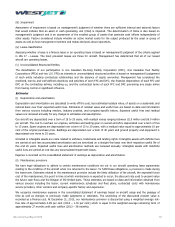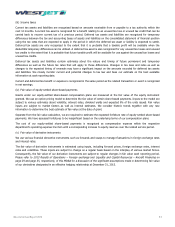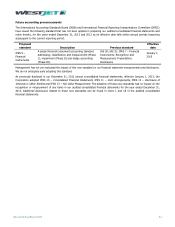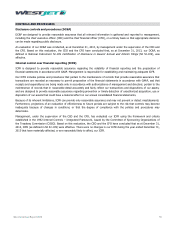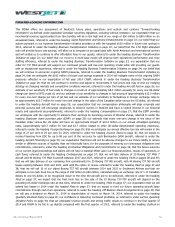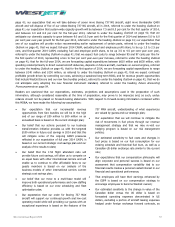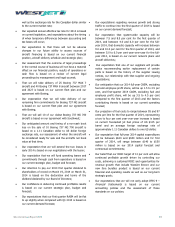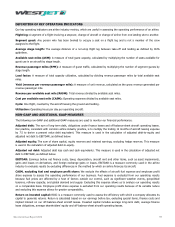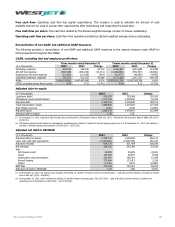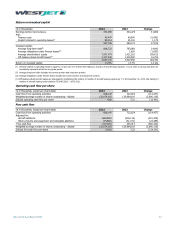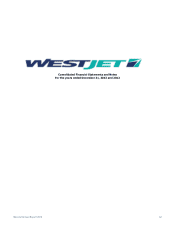Westjet 2013 Annual Report Download - page 52
Download and view the complete annual report
Please find page 52 of the 2013 Westjet annual report below. You can navigate through the pages in the report by either clicking on the pages listed below, or by using the keyword search tool below to find specific information within the annual report.
WestJet Annual Report 2013 52
(iii) Impairment
Assessment of impairment is based on management’s judgment of whether there are sufficient internal and external factors
that would indicate that an asset or cash generating unit (CGU) is impaired. The determination of CGUs is also based on
management’s judgment and is an assessment of the smallest group of assets that generate cash inflows independently of
other assets. Factors considered include whether an active market exists for the output produced by the asset or group of
assets as well as how management monitors and makes decisions about operations.
(iv) Lease classification
Assessing whether a lease is a finance lease or an operating lease is based on management’s judgment of the criteria applied
in IAS 17 – Leases. The most prevalent leases are those for aircraft. Management has determined that all of our leased
aircraft are operating leases.
(v) Unconsolidated Structured Entities
The classification of our participation in one Canadian De-Icing Facility Corporation (DFC), nine Canadian Fuel Facility
Corporations (FFCs) and two U.S. FFCs as interests in unconsolidated structured entities is based on management’s judgement
of each entity including contractual relationships and the absence of equity ownership. Management has considered the
restricted, narrow and well-defined objectives and activities of each FFC and DFC, the financial dependence of each FFC and
DFC on the contracting airlines, including us, and the contractual terms of each FFC and DFC preventing any single airline
from having control or significant influence.
Estimates
(i) Depreciation and amortization
Depreciation and amortization are calculated to write off the cost, less estimated residual value, of assets on a systematic and
rational basis over their expected useful lives. Estimates of residual value and useful lives are based on data and information
from various sources including vendors, industry practice, and company-specific history. Expected useful lives and residual
values are reviewed annually for any change to estimates and assumptions.
Our aircraft are depreciated over a term of 15 to 20 years, with residual values ranging between $2.5 million and $6.0 million
per aircraft. The cost to overhaul our engines, airframes and landing gear on owned aircraft is depreciated over a term of five
to 15 years. Spare engines are depreciated over a term of 15 to 20 years, with a residual value equal to approximately 10 per
cent of the original purchase price. Buildings are depreciated over a term of 40 years and ground property and equipment is
depreciated over three to 25 years.
Included in intangible assets are costs related to software, trademarks and landing rights. Intangible assets with definite lives
are carried at cost less accumulated amortization and are amortized on a straight-line basis over their respective useful life of
five and 20 years. Expected useful lives and amortization methods are reviewed annually. Intangible assets with indefinite
useful lives are carried at cost less any accumulated impairment losses.
Expense is recorded on the consolidated statement of earnings as depreciation and amortization.
(ii) Maintenance provisions
We have legal obligations to adhere to certain maintenance conditions set out in our aircraft operating lease agreements
relating to the condition of the aircraft when it is returned to the lessor. To fulfill these obligations, a provision is made during
the lease term. Estimates related to the maintenance provision include the likely utilization of the aircraft, the expected future
cost of the maintenance, the point in time at which maintenance is expected to occur, the discount rate used to present value
the future cash flows and the lifespan of life-limited parts. These estimates are based on data and information obtained from
various sources including the lessor, current maintenance schedules and fleet plans, contracted costs with maintenance
service providers, other vendors and company-specific history and experience.
We recognize maintenance expense in the consolidated statement of earnings based on aircraft usage and the passage of
time as well as changes to previously made judgments or estimates. The unwinding of the discounted present value is
recorded as a finance cost. At December 31, 2013, our maintenance provision is discounted using a weighted average risk-
free rate of approximately 0.99 per cent (2012 – 1.16 per cent) which is equal to the weighted average remaining term of
approximately 27 months until cash outflow (2012 – 38 months).


